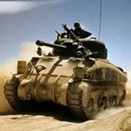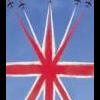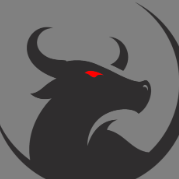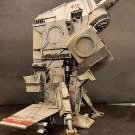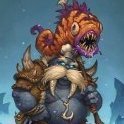-
Posts
4,276 -
Joined
-
Last visited
Kingsman's Achievements

Very Obsessed Member (5/9)
5.2k
Reputation
-
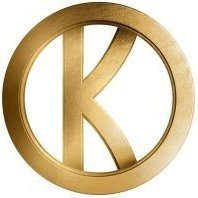
Sherman Ib, Pretoria Regiment, Italy, 1/35 Dragon
Kingsman replied to PatrikF's topic in Work in Progress - Armour
Interesting that the Polish tank has the round-topped Mediterranean style blanket box on the back of the turret, if a bit low (because of the MG stowage bracket?). Don't think I've seen this on a 105 before. That might be one of the Polish IBY HVSS 105s. I recall them being noted on a parade at the end of the Italian campaign. The hull hatches were castings and rounded on the underside but pretty square edged around the top edge. Enough to look square in 1/35. Don't use the more rounded of the 2 hatch types.- 19 replies
-
The Bovington Medium A, AKA unofficially Whippet, is green and that may be the source of the green idea. It isn't original colour. but I haven't been able to find any peeking areas of what might be an original colour under the repaints. It has been messed-about with too. The front right engine cover panel is a replacement and the left side of the cab has been removed at some time because it is now bolted on rather than riveted. The only green paint in the Handbook for Artificers 1915 edition is a Brunswick Green, a very dark green which I venture could not be made in WW1 because it relied on chrome yellow and prussian blue by this time, copper chloride having passed out of use.. Notwithstanding the possibility of Fosters still being able to make a quantity of a similar colour in 1916 from left over pigments. There was no mix for the mid greens commonly seen on models or anything like the A.MIG 074 "Green Moss for most of the UK vehicles during WW I", which is just completely wrong: too green. The MiG Ammo British and German WW1 AFV set is OK for German Buntfarbenanstrich but useless for anything British. They show a green Whippet. The AK Interactive 3G British WW1 AFV modulation set isn't bad if you like that sort of artistic unrealistic style, but none of the 4 individual colours are right. Their older 3-colour set might be better: AK4042 Khaki Brown Base isn't bad. IIRC Mike Starmer suggested SCC2 with some Khaki Green 3 being in the right sort of area.
-
Centurions did spend most of their lives in plain green, initally SCC15 then Deep Bronze Green until IRR Green/black was introduced in their late years. Painting WW1 equipment green is just lack of understanding and an assumption that army kit was green. And copying incorrectly painted preserved examples, which suffer from the same problem. Strong greens were hard for anyone to make in WW1 because of pigment shortages, notably chrome oxide. Same in WW2 as it happens. It has emerged that the MkI tanks might - and I stress might - have left the factoty in Fosters commercial pre-war Brunswick green because the contract did not specify a colour and they had the pigments to make some. But they only built the 75 Males, the 75 Females being built by Metropolitan. Presumably in Service Colour, but if their contract didn't specify either then who knows? In service all were painted in the Solomon scheme except for the 15 retained in the UK for training, 8 of which then went to Palestine and appeared by then to be Service Colour. Mk IVs, Vs and AFAIK Medium As were all finished in Service Colour. Service Colour was a greenish brown, somewhat like the WW2 SCC2 brown but a bit greener. Somewhere between SCC2 and Khaki Green 3. This is the only known surviving original paint in the UK, on a factory model at Bovington.
-
M3 Stuart in the USA. Guess the colour. M3 Stuart, again. Different lighting. Guess the colour again. Both are known to be OD and both are factory photos. But you would be forgiven for thinking they might be another colour. Like a light tan.
-

Type 57 armoured locomotive #1067 - Germany, May 1945
Kingsman replied to Tim R-T-C's topic in Ready for Inspection - Armour
That is crying out to be motorised on an N gauge chassis...... Are there any armoured wagons to go with it? Not the panzerzugs on the boxart. I would have expected camouflage painting, although camouflaging a moving locomotive on a fixed railway line and belching smoke is essentially worthless...... -
Russian tracks were manganese steel too, so the spare links would not have rusted like that. They were probably painted black but if unpainted their initial oxidation was a milk chocolate or milky coffee colour. Same with the running tracks. The oxide darkened to a dark chocolate or strong coffee colour over years.
-
The Tamiya MkIV, despite the motorisation, is the easiest build and has snap-together ready to assemble tracks. But only comes in Male form. You can omit or ignore most of the motorisation. Takom's Mk IVs are nice, IMO better detailed than Tamiya but a bit more complex to build. Their original Male-only and Female-only kits came with dreadful multi-part links, and as far as I can tell still do. They later released their ready-to-clip tracks separately. The Mk IV 2-in-1 kit has the later better tracks and will make Male or Female. The Tadpole tank is a waste of time as only a handful were converted and none were ever used. Meng's Mk V is the only show in town. Likewise Takom's Mk Is, which come with the better tracks. I don't think there is much to choose netween Takom and Meng Medium As. Don't fall into the trap of painting your tank green - they were not - or assuming they all had the red/white stripes - they did not - or slathering it with rust. So if you want a stripey one you will need a Mk IV or MK V. Mk Is in France were mostly camouflaged. In the UK and Palestine they were not. The serial numbers of all, and unit numbers names and histories of many, WW1 tanks are known and can be found here. https://sites.google.com/site/landships/home
-
Rather like all the Shermans fitted for the T6 Flotation Device which was only used once by a small number, but the redundant fittings remained. There was to be an all-new Sherman DD for the Home Islands invasion too, based on the 76mm M4A2 with HVSS. 2 were built, but also became unnecessary.
-
I thought the AHHQ kit was tooled by Trumpeter? It wasn't done by Andy....... This Facebook forum is dedicated to the AHHQ kit, so it might be useful. https://www.facebook.com/groups/792496188700019/posts/1072033444079624/?_rdr. However, I have found Facebook modelling forums to be frequently populated by the rude, ignorant, opinionated and talentless. The kit has been covered on Missing Lynx. AHHQ have 2 offerings, "WW2" with T66 track and "Korea" with T80s. You can use the Korea kit for very late WW2 but there are post-war features you will need to backdate. Engine deck door torsion bars would be the main one. but the mantlet cover was very rare in WW2.
-
The AHHQ version is, according to reviews, the better of the two kits. ILK's M4A1 hasn't gone down well either. They are gaining a reputation for poor research and poor execution with detail level not matching the enlarged scale. That may explain the discounting. I have no personal experience of either, so I can only suggest surfing some build reviews.
-
I imagine it was the black which created the perceived difficulty, as we know that Khaki Green and OD were quite similar. But again, was someone at the depot missing a trick by overpainting the black when black over Light Stone was perfectly acceptable, even preferred? Just overpaint the Khaki Green, leave the black. Noting that green and black vehicles would have been arriving before that scheme came into use. As for the 1 Dec telegram language, he could be be meaning British Standard as in BS987C. Or he could be meaning standard British as in the approved colour of the day. It is written as "British standard", noting the lower-case "s" in "standard". By which I believe he means standard British rather than BS. The 23 Dec telegram says "return to original specification Khaki Green No3", which I believe loops us back to Khaki Green being the orginal specification referred-to in the 1 Dec telegram rather than a BS colour. Which seems logical but has a degree of assumption. Which does not answer the question of whether any or all of the 3 Grant manufacturers were actually using Khaki Green, potentially sourced from Canada? Or whether even the 2 that were building tanks solely for the UK under UK cash contracts and beyond US Ordnance direct control for 80% of production were following a US Ordnance direction to use OD, and we simply accepted that. Which on the face of it seems a bit far-fetched: improbable but not impossible. US Ordnance had a lot more to worry about than mandating colours for export orders made directly with suppliers in which they were not involved for kit they were not using. Perhaps OD was accepted in order to have uniformity with tanks coming from plants which were mandated to use OD? But if OD had already been accepted why didn't they just say so in the telegrams? Which leads me to think that we really are talking about Grants in Khaki Green. And we are no closer to the original question about Coronado or Coranado Tan. For which no firm evidence has been unearthed so far either side of the 49th Parallel. I am still of the belief that the instruction was countermanded before it could actually be implemented on Grants.
-
The Asuka and Dragon DV kits are essentially the same variant - DV with rear-roller bogies. The Asuka description is misleading as the only part that makes this suspension even remotely "early" is the 2nd pattern track skid: it isn't even the truly early 1st pattern. Asuka did once offer a version with the early top-roller M3-type bogies, as did Dragon in their Cyber Hobby range, but those are long gone. I ended up getting an Asuka spare suspension set to do that, keeping the Dragon kit as OOB. This Dragon kit now has the new tracks and a metal gun barrel. That version will have the red flash on the end of the box like this on the left. But I am seeing box art advertised with the very different front on the right. The catalogue number has not changed, annoyingly. So if buying, check carefully what you're getting. There are a lot of the older ones out there with DS tracks, especially 2nd-hand. And some sellers are just using the old boxart. Either of these later Dragon M4A2 Sherman IIIs will also work for later in the Desert in Tunisia and then through Sicily into Italy. The left one is Pullman-Standard, the right one Fisher. I haven't seen either of these with the new tracks yet. Beware the red flash on the left box if you see it (not on all boxes) as this only trumpets the DS tracks you really don't want.
-
The reverse is typically the case in the UK. While you can find Asuka bargains occasionally, they typically outprice Dragon by at least £10. Of course you can pay through the nose for Dragon. But I've just picked up both their Sherman II DV and Sherman III DV both with the new tracks for £48 each, from retailers not eBay resellers - where you do see price gouging. The RFM Firefly is also typically at least £10 cheaper in the UK than Asuka, although initial pricing of their new 75mm A4 is comparable to Asuka. Asuka has never had a stable UK agent, which doesn't help. I understand that supply is unreliable but this may be beyond their control. We are seeing feast and famine from a lot of Far East manufacturers because of steep rises in shipping costs. A large consignment of Bronco recently arrived in the UK, but it is the first for many months and another is not expected for many months. Get it while you see it. Kits have a low value to volume ratio compared to many other goods, especially electronics, and companies can no longer afford their own containers. They are forced to seek spare space in other shipments. The very best pricing, even allowing for shipping and import dues, is direct from Japan on the Asuka website. Their accessory sets and parts are ridiculously cheap there. About half what you would pay in the UK even if you could find them, and spare sprues are only available direct. Their shipping is reasonable, better the more you have, and 20% import VAT + £10 still leaves you quids in.
-
I think you have the answer: not precisely known. And probably concurrent in that new orders for later Marks were issued while contracts for earlier Marks were still being fulfilled. And then there are the Centaur contracts completed as Cromwells and we know that some manufacturers changed Marks mid-production. As we have seen with the EE Mk Is and Mk VIs. It is probably safe to say that only Mks IV, Vw, VI and VIIw with Types D, E and F hulls were built after the Final Specification was issued in early '44 (Jan?) and these are the only Marks you would expect to see in NW Europe. But the situation was confused. Bovington's Type C hull Mk IV has the applique armour under the fighting compartment floor, supposedly the main difference between Type D and E. Was that an attempt to make otherwise-suitable Type C's deployable? It also has the flat trackguards, making it indistinguishable from a D from the front. The diagrams in Tank Power and elsewhere showing hull type variations are typical or illustrative at best rather than definitive, as period real-world variations are seen. I hope to get into Bovington to have a look at their contract cards and in their Cromwell archive boxes some time in the next couple of months. But I have a strong suspicion that the information previously published by David Fletcher in his Osprey book on the subject may be all that they have on the subject of marks, numbers, manufacturers and dates. He of course had unlimited access to their archive while he worked there as Curator and Historian. Tank Power has nothing new in that regard. And the recent re-publication of the very old Fletcher Cromwell book is of very limited use with very limited historical information including some that is known now to be incorrect. It is mostly a facsimile of the vehicle handbook. And to repeat a cry from earlier, yes we really need a really good book on the A24-A27-A30-A34 family.
-

Sherman Ib, Pretoria Regiment, Italy, 1/35 Dragon
Kingsman replied to PatrikF's topic in Work in Progress - Armour
Here are some more views of the hull side of the same M4A4. There are 2 or 3 layers of paint here but there is no perceptible texture. Nothing you would see in 1/35 beyond the natural texture of a matt paint. Chrysler Tank Arsenal was by some margin the largest Sherman builder with about 18,000: over 21,000 if you include M3s. Fisher came a distant second with about 11,000. Chrysler manufactured more of their tanks in-house than anyone else did and as a result had a much more settled supply chain than some other assembly plants. They also manufactured many variants unique to them, M4(105) being one. So they were less variable in features than some variants assembled at multiple plants. And they built damn good tanks with high quality workmanship. AFAIK Chrysler did not have their own armour plate foundry. I suspect their plate probably came from AS&F, the largest single manufacturer of AFV armour plate in the US during WW2. But regardless of foundry, US armour plate was of very uniform quality and Ordnance District inspectors were all over it. An entire batch of Cromwells were sentenced as Training Only and marked as Unarmoured because of sub-standard frontal armour: that did not happen with Shermans. Although there is some question over the early cast hulls before Continental Steel had sorted out how to evenly cool such large and variable-thickness castings. I do have occasional access to an M4(105) with HVSS, Sherman IBY, one of the 100 or so shipped and one of a handful that came to the UK: most went to Italy and the Poles certainly had some there. But I don't have any pictures of it. Having just acquired this same Dragon kit, it is on my lens list. Further down are a couple of 75mm turrets for texture comparison. The 105mm turret was a variant of this. Again, noticeably smooth. Ignore the weld scars here where the smoke discharger bracket once was. No idea what the 2 square scars are. We typically added these footman loops on the left turret side on 75mm tanks. Don't know about 105s. I supect tanks supplied directly to Italy did not receive the same little modifications applied to tanks processed through the UK. The rough band around the horizontal axis of the turret roughly level with the rear lifting rings is quite often seen on 75mm turrets, but I haven't traced it to a particular foundry. Don't know if seen on 105s. By that time the number of foundries making the "small" turret would have dropped considerably. Once 76mm production began only a little over 2,200 tanks were built with the "small" turret over the last 18 months or so or production.- 19 replies


